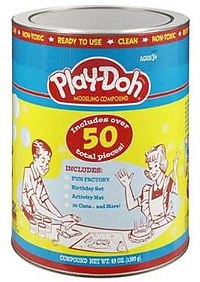
National Play-Doh Day celebrates a great childhood play toy. Invented in the mid 1950s, it has entertained millions of children, and allowed them to express their creativity, both at home and in the classroom.
The invention was simple. A school teacher wanted a safe modeling clay for her pre-schoolers. She asked her brother-in-law Joseph McVicker, who worked at a chemical company, to come up with something. The result was simple....flour, water and food coloring.
Its fun and easy to celebrate National Play-Doh Day. Simply pull out the Play-Doh and ......Play! There are other brands of play clay on the market. Having raised three children, this author has never seen a better brand than Play-Doh.
Origin of National Play-Doh Day:
 Play-doh was created in 1955 by Joseph McVicker of Kutol Chemicals in Cincinnati, Ohio. It hit the market in 1956, and has been a popular play toy ever since. It was created because McVicker's sister-in-law wanted a safe, clay-like product for her nursery school children to use. Noah and Joseph McVicker received U.S. Patent No. 3,167,440 for Play-Doh.
Play-doh was created in 1955 by Joseph McVicker of Kutol Chemicals in Cincinnati, Ohio. It hit the market in 1956, and has been a popular play toy ever since. It was created because McVicker's sister-in-law wanted a safe, clay-like product for her nursery school children to use. Noah and Joseph McVicker received U.S. Patent No. 3,167,440 for Play-Doh.
Hasbro Toys, the current makers of Play-doh, say it a little differently. From their website, they state: "The story of PLAY-DOH modeling compound begins in 1956 when scientists at Rainbow Crafts, a Cincinnati soap and cleaning compound company, stumbled upon a new use for the unique dough-like cleaning product. The company realized this product’s potential as a child’s modeling compound; and thus, the original, reusable PLAY-DOH compound was born."
Eight Tips on Building Fun with Your Kids
Hasbro's Play-Doh has come along way since it's modest beginnings over 50 years ago. Today, Play-Doh is still a classic toy that enables children to create anything their imagination desires. That's called Free Play. Here are a few ideas to inspire your kids.
Tip #1: Not all Play-Doh is made alike. Generic brands simply don't match up to the original. Some generic brands are also toxic and should be avoided at all costs (or even if it's free).
Tip #2: You can use Play-Doh indoors or out! Set up a table outside if you prefer not to make an indoor mess. Or use in the kitchen where the pieces can be swept up, once dry.
Tip #3: If Play-Doh is dropped on the carpet, let it dry. Once it's dry, the pieces are much easier to pick up or vacuum. If you attempt to clean while the dough is still wet, it will be much harder.
Tip #4: Kids LOVE Play-Doh. Even older children will engage if they see that the dough is out and ready to be manipulated. Use this to your advantage and invite all children to the table (bonding, right?): even the teens, yes.
Tip #5: Many children like to smoosh the Play-Doh colors together. The result will be a big icky looking brown pile of goo. Decide up front if you will allow for this. Do you want the colors to remain seperate? If so, you need to lay down the Play-Doh law from the get-go. Otherwise...brown goo will ensue.
Tip #6: Some kids need a little guidance when it comes to making shapes, creating bugs, designing patters and so on. Don't be bossy about it but offer to help, as needed.
Tip #7: Some children want to be in charge of their Play-Doh creations. No help needed, thanks! That's okay, too - let it fly!
Tip #8: The many pluses of Play-Doh can include developmental benefits such as: fine motor skill use, color association, creativity, critical thinking, sharing, self esteem (in a job well done), free play and of course...fun! You could also use the dough to create letters, numbers and names.
Happy National Play-Doh Day!